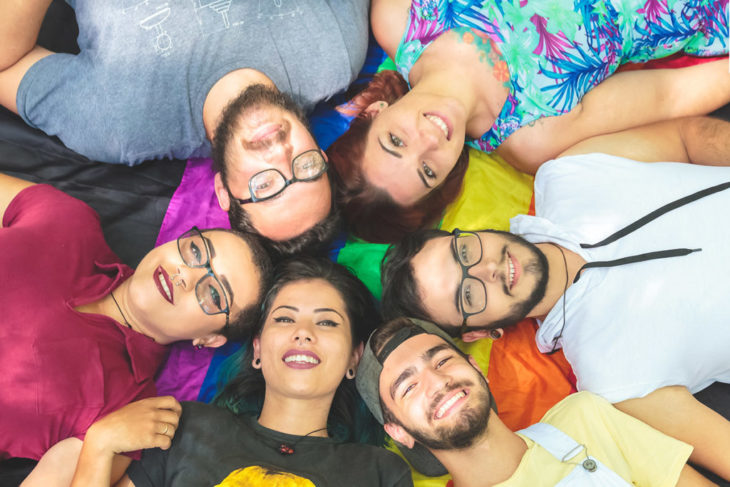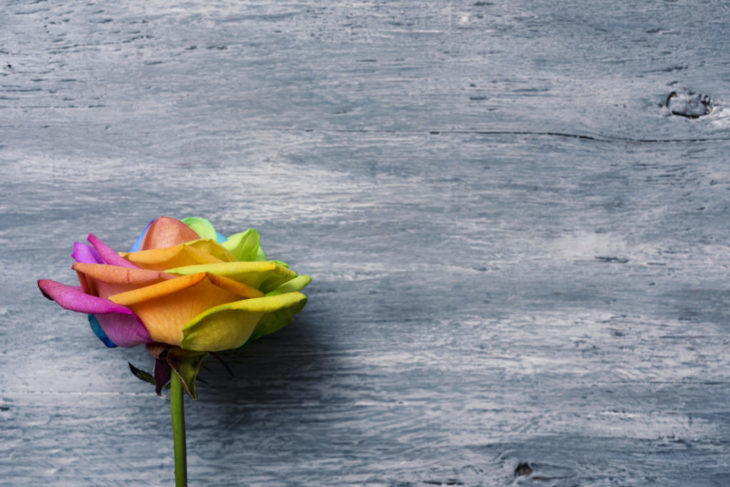“You’re either gay, straight, or lying.”
I first heard that oft-repeated phrase when I was an 18-year-old freshman at UC Berkeley. I was at my first meeting of the GLBA (Gay, Lesbian, and Bisexual Alliance). I’d recently broken up with a girlfriend, and had been dating (and sleeping with) both men and women; I was ready to “come out” as bi and to get involved in campus activism. But as I quickly found out, though there were equal numbers of gay men and lesbians in the group, the only bisexuals were women. And while many of those women faced a certain amount of “bi-phobia,” at least the GLBA acknowledged their existence.
Bisexual men, I was told, didn’t exist: we were either cowards or liars, too scared or too dishonest to admit we were really gay.
The stereotype of the man who pressures his girlfriend to have a threesome with another woman is justly famous, but I can attest that the reverse is not as rare as might be imagined.
This belief that bi men are the unicorns of the sexuality spectrum remains tenacious. A widely cited 2005 study found no evidence that men could be sexually attracted to both genders. (The study involved showing both gay and straight porn to a group of men who identified as bi. Seventy-five percent of the men in the study were physiologically aroused only by the gay erotica—and the other 25 percent only by the hetero stuff. No one was equally turned on by both.)
One of the corollaries to this dismissiveness of the possibility of male bisexuality is what I call the “sexual one-drop rule.” The original one-drop rule, developed in the Jim Crow era, declared that anyone who had as much as a drop of “Negro blood” was to be considered “colored.” To be white, one had to be free from any African ancestry. The sexual version is similar: It declares that any man who has any sexual attraction to other men is gay. Women can have complex and fluid desires, but men live by a strict dichotomy. You either are or you aren’t, and if you’ve ever wanted to #&@$% a man (or acted on that want), then you’re gay. End of story.

Source: Rainbow Life
I ran into the one-drop rule just a month ago. My wife and I were out to dinner with a good friend of ours, a single woman in her 40s. She was sharing her war stories from the cyber-dating world, and mentioned having met a great guy whom she really liked—until he let slip, on the third date, that he had had boyfriends as well as girlfriends in the past. “That ended that,” our friend said. “If he’s been with men, then he’s gay in my book.”
I chose the moment to share my own history of having dated both men and women. Our friend was floored. She kept looking at my wife, her eyes seemingly asking the question her lips wouldn’t speak: “How can you trust him to be faithful?” My wife just smiled her Mona Lisa smile in return.
I’ve known I was attracted to both men and women since my early teens. Long before I’d been kissed, my sexual fantasies featured both boys and girls. I remember the trepidation and excitement I’d feel changing for PE classes, desperately afraid I’d get an erection and be outed. (It never happened, thank goodness.)
I was equally eager to see naked girls—I just had much less opportunity to do so, at least in real life. At age 14, I found a porn magazine featuring a pictorial of two men and a woman, and I used that as a masturbation aid for months until the pages literally fell apart.
My introduction to sex with men came in a ménage a trois. My first teenage girlfriend, who had her own kinky streak, knew my fantasies and wanted to see me with another man. She set up a threesome with a co-worker from her job at an ice cream store. It was the most erotically memorable experience of my high school years, and is something I still think about on the rare occasions I find myself in a Baskin-Robbins. After that girlfriend and I broke up, I had sex with a series of men (and women) over the next several years.
But before I went to my first GLBA meeting, I’d figured out something about myself. While I was sexually attracted to both men and women, I found the idea of actually falling in love with a man to be preposterous. With men, I wanted hot sex and nothing else. I didn’t even enjoy kissing guys (the stubble burn was a turn-off. I had no idea how women endured that.) But I knew from experience that I could fall in love with women. On a physical level, I was drawn to both; on a romantic plane, I was straight as an arrow.

Source: Beaches Recovery
Researchers on bisexuality have often noted that those who identify as bi often have that same heart/body disconnect that I experienced. In the 1860s, the pioneering sexual rights crusader Karl Heinrich Ulrichs wrote of “conjunctive” and “disjunctive” bisexuals. The former could be sexually and romantically drawn to both genders, while the latter could fall in love with just one sex while still lusting for both. Ulrichs claimed that “disjunctives” came in both varieties (some bisexuals could fall in love with their own sex but not the other; some could fall in love with the opposite sex but not their own. But in order to “qualify” as bisexual, disjunctives needed to have physical desire for both men and women.)
Ulrichs considered both conjunctive and disjunctive bisexuality in both sexes to be a normal variation on the human condition. Though he was scorned and mocked for his enlightened views, the real tragedy may be that he wasn’t just ahead of his time—when it comes to accepting male bisexuality as authentic, he’s ahead of our time.
In more than a quarter-century of thinking, writing, and eventually teaching about male bisexuality, I’ve become convinced that the inability to accept the reality of bisexuality in men is linked to fears about fidelity. The myth that men are naturally promiscuous while women are naturally monogamous endures. So we assume that a bisexual woman can make a commitment to either a man or a woman, and that she’ll be able to stay faithful. But we already think straight men have a hard enough time remaining true—the expectation that a bisexual man will invariably cheat is high. When our friend shot my wife that look when I revealed my sexual history with men, I’m fairly sure that’s what she was thinking: He’s either lying or cheating.
But though she didn’t ask, she may have been wondering how my wife coped with the visceral reality that I have had sex with men. We live in a culture in which sex between two women is regularly eroticized while sex between two men gets labeled “disgusting.” While the most fervent declarations of revulsion at the thought of guy-on-guy sex are usually from men (especially the ones who feel pressure to prove their heterosexual bona fides), I’ve known plenty of women who liked gay and bi men perfectly well—but were repulsed by the thought of what those men actually do in bed.
In my younger, single years, I found that women had two reactions to the discovery of my bisexuality. (It wasn’t something I often announced on first dates, but I rarely kept it a secret for long.) Some women, like my first girlfriend, found the idea incredibly hot. The stereotype of the man who pressures his girlfriend to have a threesome with another woman is justly famous, but I can attest that the reverse is not as rare as might be imagined. Though only one woman went so far as to arrange a ménage a trois with another guy, there were a couple of others who loved it when I would recount erotic details to them in bed.
The second reaction was, of course, disgust. I can recall dating a grad school classmate of mine back in the early ’90s. Liz had impeccable liberal credentials (a Wellesley alumna, she’d experimented with women in her teens), but her progressive politics stopped cold at the thought of dating a man who had had sex with other men. “I’m so sorry, Hugo,” she said when she told me she was calling things off. “I’ve got no problem with gay men. But I can’t be intimate with a man who’s done what you’ve done without getting a giant image in my head of what you’ve done. And forgive me, but it’s just … gross.”
If there are two things you can’t talk people out of, it’s what gets them hot and what turns them off. Once the truth came out, I had no chance with Liz.

Source: Forerunners of America
But in the end, the big fear so many people have about bisexuality really does revolve around the capacity to be faithful. I can’t speak for every man who has dealt with a lifetime of sexual attraction to both men and women. But I can speak from my own experience, which is that monogamy is no harder for bisexuals than it is for straight or gay folks. Even if you’re only sexually attracted to females, there’s no way your wife or girlfriend can possibly embody everything that draws you to women.
One of my exes had a beautiful voice, a soprano so breathtaking it brought tears of joy to my eyes. My beloved wife, Eira, has a thousand amazing talents, but can’t carry a tune. I’m no more likely to leave the mother of my daughter for a man than I am to leave her for a member of the L.A. Master Chorale. No partner can be everything to us. Every honest heterosexual in a monogamous relationship admits that his or her partner lacks something that others might have. It’s no different for bisexuals. Really.
Before making a lifetime commitment to someone, almost everyone—gay, straight, or bi—struggles with the realization that if everything works out as they hope, they’ll never have sex with anyone other than their partners for the rest of their lives. Lots of people find that terrifying. But that’s a general fear about the loss of possibility rather than a specific anxiety about not being able to sleep with a particular type. An engaged man might have some misgivings about fidelity, but he’s not thinking “Damn, my fiancée is a brunette. I’ll never #&@$% a natural blonde again.”
We accept that women’s sexuality is remarkably fluid. That’s a good thing, as that recognition opens up a whole world of possibility. But the flip side is the continued insistence that male sexuality is static, simple, and comes in only two distinct flavors: gay or straight.
That thinking doesn’t just sell bisexual guys short. It reinforces the toxic myth that men can never have inner lives as rich, complex, and surprising as women so evidently do.
This piece was originally published at The Good Men Project Magazine.
Original by Hugo Schwyzer
